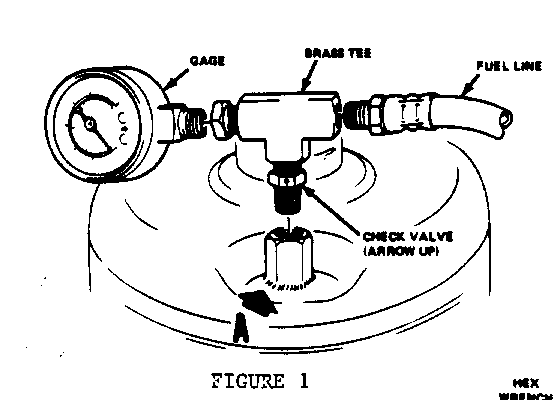ON-VEHICLE CLEANING OF PORT FUEL INJECTORS

Model and Year: ALL 1985-86 VEHICLES EQUIPPED WITH PORT FUEL INJECTION ENGINES
TO: ALL CHEVROLET DEALERS
If deposits form on the tip of port fuel injectors, the engine may experience rough operation. These deposits reduce fuel flow and cause a lean condition. Analysis of returned injectors have shown a high percentage of good injectors being replaced. THE PURPOSE OF THIS BULLETIN IS TO EMPHASIZE THAT ON-VEHICLE CLEANING SHOULD BE USED INSTEAD OF INJECTOR REPLACEMENT.
ESSENTIAL TOOL:
1. Kent Moore Tool #J-35800 is required.
2. Shipping of tool to dealers started 11-26-85.
3. All dealership should receive their tool by 12-31-85.
SERVICE PROCEDURE:
1. Identify lean injectors by performing injector balance test as described in the 1986 Service Manual, Section 6E3. If no lean injectors are found, determine the cause of engine roughness and correct. Cleaning may not be necessary.
2. Clean injectors using Kent Moore Tool #J-35800.
NOTICE: TO USE THIS DEVICE THE VEHICLE FUEL SYSTEM MUST HOLD PRESSURE. IF IT DOES NOT HOLD PRESSURE, REPAIR AS REQUIRED. ENGINE MUST BE FULLY WARMED UP AND SHUT OFF BEFORE ATTACHING THIS TOOL.
A. Add approximately 1/2 gallon of mixture of 95% gasoline and 5% cleaner to J 35800 tank.
NOTICE: DO NOT EXCEED THE 5% CONCENTRATION OF CLEANER AS DAMAGE TO THE FUEL SYSTEM MAY RESULT.
USE ONLY APPROVED INJECTOR CLEANING SOLVENTS, SUCH AS, 1050002 GM TOP ENGINE CLEANING OR X66-P AC-DELCO CARBURETOR TUNE-UP CONDITIONER.
B. Attach J 35800 hose end to vehicle fuel rail pressure test connection.
C. Pump J 35800 until pressure gauge reads 25 P.S.I.
D. Open J 35800 inline valve 1/2 turn.
E. Disable vehicle in-tank fuel pump.
F. Start and run engine at 2000 RPM until 1 1/2 quarts of solution is used.
- 8 cylinder approximately 10 minutes. - 4 and 6 cylinder approxiniately 15 minutes.
G. Stop Engine.
H. Close J 35800 inline valve and disconnect J 35800.
I. Recap vehicle test fitting ar.d connect vehicle fuel pump.
J. Immediately run engine for 5 minutes at 100012000 RPM to flush cleaner from fuel rail and injectors.
NOTICE: DO NOT ADD THE CLEANER DIRECTLY TO THE VEHICLE GASOLINE TANK AS DAMAGE TO THE FUEL SYSTEM MAY RESULT.
AFTER THE INJECTORS ARE CLEANED, OWNERS SHOULD BE ADVISED THAT USE OF FUELS WITH DETERGENT ADDITIVES SHOULD KEEP THE INJECTORS CLEAN. PREMIUM UNLEADED GASOLINES GENERALLY CONTAIN LOWER LEVELS OF MATERIALS BELIEVED TO FORM DEPOSITS, AND HIGHER LEVELS OF DETERGENTS THAN REGULAR UNLEADED GASOLINES. THEIR OCCASIONAL USE COULD HELP PREVENT FUTURE INJECTOR DEPOSIT FORMATION.
There are encouraging signs that oil companies are addressing deposit formation and will be providing regular and premium unleaded gasolines with higher levels of detergents which can prevent and in some cases even remove injector deposits. This will be a welcome development not only for Chevrolet owners, but also for owners of other domestic and foreign cars equipped with port fuel injection system. Local gasoline advertising is one guideline for selecting fuels with high detergent content.
Labor Operation Number: T1143 Labor Time : 1.1 Hours
Model and Year: 1985-86 PORT FUEL INJECTION ENGINES KENT MOORE TOOL J 35800
TO: ALL CHEVROLET DEALERS
This supplements Bulletin 86-19 dated February 1986, with information pertaining to the essential tool #J-35800.
A possibility exists that some of the subject tools may have been assembled and shipped to dealers with the fuel pick-up tube retaining screw not fully tightened. This could cause an internal leak and not allow the gasoline/ cleaner mixture to enter the engine fuel system. This poses no danger or fire hazard.
Since the tool is shipped with the fuel hose, gage, check valve and brass tee fitting unassembled and not installed on the tank, the retaining screw should be checked prior to assembly. See Figure 1.
If these parts have already been assembled remove as shown in Figure 2.
NOTICE: Use back-up wrenches on all fittings when removing and installing.
1. Tighten retaining screw as shown in Figure 2.
2. Reinstall parts using a good quality thread compound on all threads prior to assembly.


General Motors bulletins are intended for use by professional technicians, not a "do-it-yourselfer". They are written to inform those technicians of conditions that may occur on some vehicles, or to provide information that could assist in the proper service of a vehicle. Properly trained technicians have the equipment, tools, safety instructions and know-how to do a job properly and safely. If a condition is described, do not assume that the bulletin applies to your vehicle, or that your vehicle will have that condition. See a General Motors dealer servicing your brand of General Motors vehicle for information on whether your vehicle may benefit from the information.
